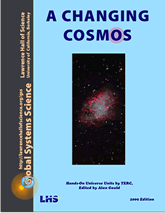AC4.1.2. The Parallax of Asteroid Austria
by Rich Lohman
Materials
Image Processing software such as
- JS (online app) – https://js9.si.edu
- JS9-HOU – https://hou-js9plugins.educontinuum.org
- SalsaJ available from European HOU site
Images:
Background:
Many of the asteroids which circle the sun are located in the region between the orbits of Mars and Jupiter. This is known as the Asteroid Belt. Because these objects are relatively close to the Earth their distance can be measured by parallax if the baseline is long enough. In this particular activity you will use two images taken of an asteroid known as “Austria”. These images were taken by the same telescope about an hour apart. Since the Earth has rotated and moved along its orbit during that time the two images were actually taken from two different positions in space. These two different positions will define the baseline. When you examine the two images on the computer you will be able to observe and measure the parallax shift of the asteroid. Knowing the length of the baseline will allow you to calculate the distance to the asteroid.
Goals:
- To observe and measure the parallax shift of the asteroid “Austria”.
- To determine the factors that define the baseline for this measurement.
- To calculate the distance to “Austria”.
Procedure:
- Launch Image Processing (IP) program.
- Locate and open the two files entitled “AustriaV1A” and “Austria-V_2”.
- Place them side by side on your screen, with V1A on the left, and adjust their sizes so they both fit on the screen.
- Both of these images were taken on May 18, 2006, from a telescope in Perth, Australia. The telescope was operated remotely through the internet from Berkeley, California, by a group of college students. Image V_2 was taken 51 minutes after V1A.
- This particular asteroid is relatively easy to locate by just spending some time comparing the two images. You are looking for a fairly bright object which has changed its position from one image to the next. All other objects in the image are distant stars which maintain their same position over the 51 minutes, so if you see a “star pattern” that has changed then one of those “stars” must be the asteroid. See if you can find it.
- Now that you have found the asteroid you want to determine how much it has “apparently” moved. Use the appropriate IP software tool to find and record the (x,y) pixel coordinates of the asteroid in each image.
- To verify that all other stars have remained in their same position, check the positions of at least one other star in both images. What do you notice about their coordinates?
- The parallax shift can be calculated from the coordinate measurements, but it can be done more easily by “subtracting” image V_2 from image V1A. Perform the subtraction, then locate the “black-white” spots which show that those objects have shifted from one image to the next. You can check the coordinates of those spots if you wish to compare with your measurements above. Then use the appropriate IP tool to measure the distance between the two spots. This is the parallax shift in units of pixels.
- To determine the actual parallax shift in angular units you need to know something about the telescope and camera that took these images. The particular piece of information you need is called the “plate scale”. It is a conversion factor, unique to each telescope, that converts the pixels in the image to an angle in arcseconds. For the telescope in Perth the plate scale is 1.2 arcsecs/pixel (usually written 1.2 “/px).
- Using the given plate scale convert the “distance” in pixels (from step #9) to arcseconds. The result of this calculation is the parallax shift of the asteroid.
- Consider, for a moment, the size of this shift. Can you picture how small that angle is? For comparison, the Hipparcos satellite has the capability of measuring parallax angles as small as a few milli-arcsecs!!
- So we come to the point of finally determining the distance to asteroid “Austria”. From the presentation earlier you know that you need to know the baseline for this measurement. Even though the two images were taken from the same telescope, the fact that the Earth has moved during those 51 minutes means that the telescope was in a different location in space. In addition, the asteroid has also moved during this time. So the determination of this baseline is rather complicated.
What are the various motions that might cause this apparent shift in the images you are looking at? Make a list of the possibilities, and make a drawing to help. Consider each possibility in turn. Which seem to be more important than others? Make an initial assumption to set a baseline. Calculate the distance to “Austria” using that baseline. Check to see if your initial assumption was justified. If not, make an adjustment and go from there. What is your best estimate of the Earth-“Austria” distance?
A few reference distances from the Sun: to Earth (1 AU); to Mars (1.5 AU); to Jupiter (5.2 AU)


